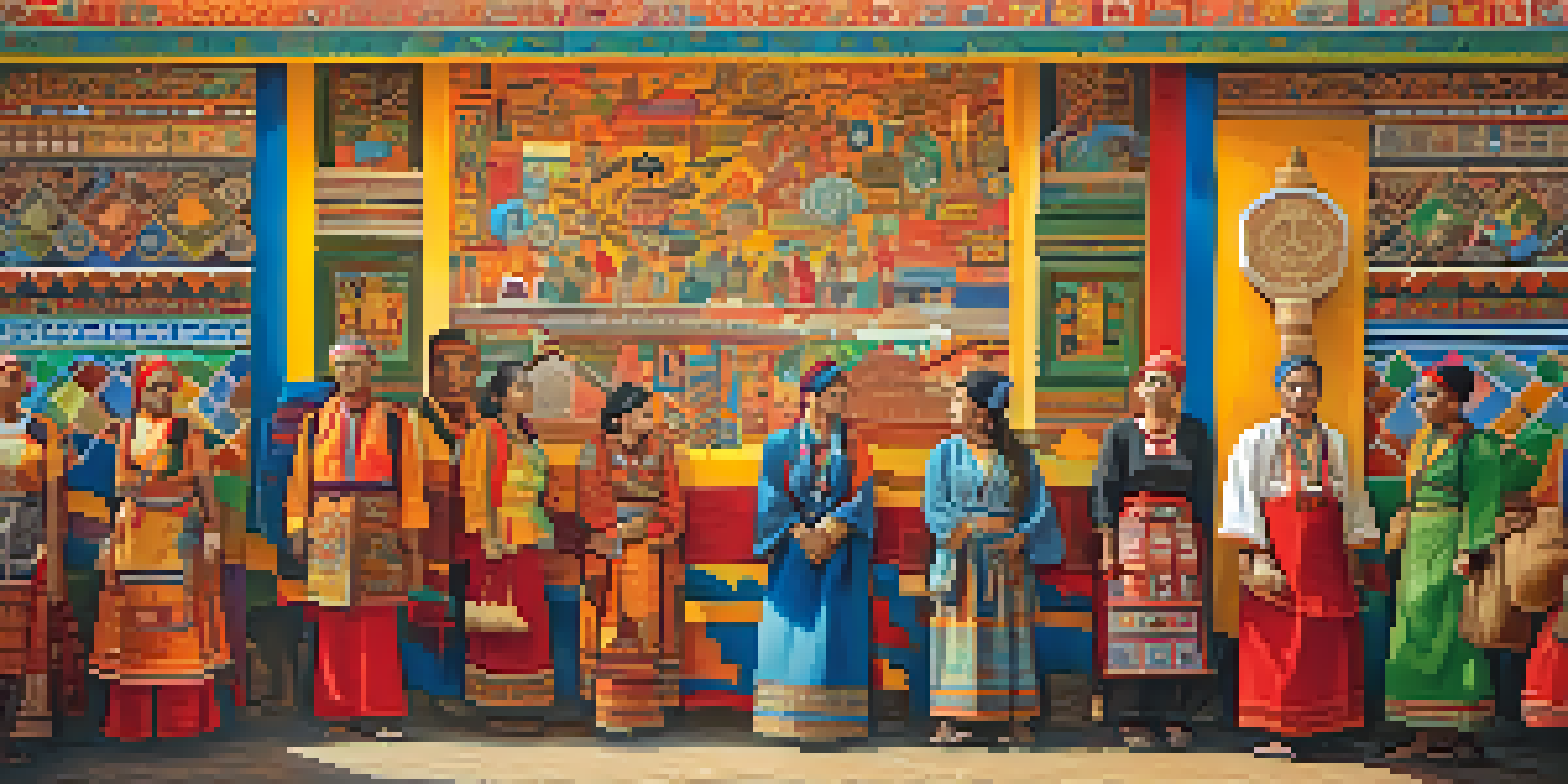The Role of Art in Shaping National Identity Representations

Understanding National Identity Through Art
National identity is a complex tapestry woven from history, culture, and shared experiences. Art serves as a powerful medium through which this identity is expressed and explored. It allows individuals to connect with their national heritage and fosters a sense of belonging within a larger community.
Art is the most beautiful of all lies.
For example, national anthems, flags, and monuments are all artistic representations that evoke feelings of pride and unity. These symbols often reflect the values and struggles of a nation, encapsulating its essence in a tangible form. Thus, art becomes a lens through which citizens can view and understand their collective identity.
Moreover, art can also challenge and redefine national identity by questioning traditional narratives. It opens up dialogues about who we are as a nation and encourages a more inclusive understanding of our diverse backgrounds.
Art as a Historical Record of National Identity
Art has long served as a historical record, capturing moments that define a nation's identity. From paintings depicting key historical events to sculptures commemorating national heroes, these works provide a visual history that can be both informative and emotionally resonant. They allow future generations to learn about their heritage in a way that textbooks often cannot.

For instance, the art produced during the Renaissance in Italy not only highlights the beauty of that era but also reflects the evolving ideas of humanism and nationalism. Similarly, contemporary artists often tackle current societal issues through their work, making art a living record of national identity as it evolves.
Art Reflects National Identity
Art serves as a powerful medium that expresses and explores national identity, connecting individuals to their heritage and fostering a sense of belonging.
In this way, art does more than just preserve history; it influences how we view our past and shapes our understanding of who we are today. It invites us to reflect on our national story and consider what it means to belong.
Cultural Symbols and Their Role in National Identity
Cultural symbols, often portrayed through art, play a critical role in shaping national identity. These symbols—like folklore, traditional costumes, and local crafts—embody the unique characteristics of a nation. They serve as reminders of shared experiences and cultural heritage, fostering a collective memory.
Every artist dips his brush in his own soul, and paints his own nature into his pictures.
For example, indigenous art forms often convey deep connections to land and spirituality, which are central to the identity of many nations. Through exhibitions and performances, these cultural symbols are celebrated, allowing both locals and visitors to appreciate the richness of a nation's identity.
Artistic expressions of cultural symbols help to reinforce a sense of pride and belonging among citizens, while also promoting understanding and respect among different cultures. This interplay of representation encourages a broader dialogue about identity in a multicultural world.
The Influence of Political Context on National Identity Art
The political landscape of a nation greatly influences how art is created and interpreted in relation to national identity. During times of conflict or change, artists often use their work to comment on societal issues, making art a powerful form of resistance or advocacy. This reflects the struggles and aspirations of a nation at a particular moment in time.
For instance, during the Civil Rights Movement in the United States, artists created powerful works that highlighted the fight for equality and justice. These pieces not only documented the struggle but also became symbols of national identity and progress.
Cultural Symbols Shape Identity
Cultural symbols portrayed through art reinforce national identity by embodying shared experiences and promoting understanding among diverse communities.
Thus, art can serve both as a mirror reflecting the current state of a nation and as a catalyst for change. It encourages citizens to engage with the political discourse surrounding their identity, prompting deeper conversations about who they are and what they stand for.
Art as a Unifying Force in National Identity
Art possesses the unique ability to unite people under a common identity, transcending individual differences. Festivals, concerts, and public art installations often bring communities together, creating shared experiences that strengthen national identity. This sense of unity is crucial, especially in diverse societies where varying backgrounds can lead to fragmentation.
For example, national art competitions or collaborative projects encourage participation from various segments of society, fostering inclusivity. When individuals come together to create or celebrate art, they cultivate a shared sense of belonging and purpose.
Moreover, these gatherings can serve as platforms for dialogue, allowing different voices to be heard and appreciated. By celebrating art, nations can reinforce their identity while also embracing the diversity that enriches it.
The Role of Art in Global Perceptions of National Identity
Art plays a pivotal role in shaping how nations are perceived on the global stage. Through international exhibitions, films, and performances, countries showcase their cultures and identities, challenging stereotypes and fostering connections with others. This exchange of artistic expression can enhance a nation's reputation and soft power.
For instance, countries like Japan have successfully utilized their traditional art forms, such as anime and calligraphy, to share their cultural identity worldwide. This not only boosts tourism but also encourages cultural appreciation and understanding on a global level.
Art Influences Global Perception
Through international exhibitions and artistic exchanges, a nation's art shapes how it is perceived globally, enhancing cultural appreciation and soft power.
Consequently, the way a nation presents its art can influence external perceptions and relationships. By engaging with the international art community, nations can share their narratives and redefine their identities in a global context.
The Future of Art in Shaping National Identity
As societies evolve, so too does the role of art in shaping national identity. The rise of digital platforms allows artists to reach broader audiences and share their unique perspectives on identity in innovative ways. This democratization of art means that diverse voices can contribute to the national narrative.
Moreover, as globalization continues to influence cultural exchange, national identity may become increasingly fluid, incorporating elements from various cultures. Artists today are navigating this complexity, blending traditional forms with contemporary influences to reflect the realities of modern life.

Looking ahead, the future of art in shaping national identity will likely be characterized by collaboration and dialogue. By embracing this evolution, nations can foster a richer, more inclusive understanding of identity that resonates with both their citizens and the global community.